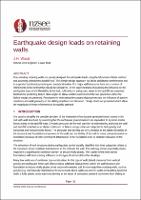| dc.contributor.author | Wood, John | |
| dc.date.accessioned | 2023-02-21T01:18:11Z | |
| dc.date.available | 2023-02-21T01:18:11Z | |
| dc.date.issued | 2022-04-27 | |
| dc.identifier.uri | https://repo.nzsee.org.nz/xmlui/handle/nzsee/2478 | |
| dc.description.abstract | Free-standing retaining walls are usually designed for earthquake loads using the Monobe-Okabe method and assuming cohesionless soil backfill. This simple design approach has led to satisfactory performance and is supported by laboratory testing and analytical studies. For major wall structures there are a number of refinements to the method that should be considered. These include: The flexibility of the wall calculating the expected outward displacement. Predicting the failure plane angle (required to determine backfill properties). Inertia forces for a backfill with both cohesion and friction (important if the failure plane enters natural ground). Predicting the earthquake modified passive resistance acting on the toe of the wall. The effect of wall geometry on sliding resistance . Influence of vertical acceleration on loads and displacements. Modification of the earthquake inertia load from ground water in the backfill. The paper reviews published information on the above topics. Design charts are presented which allow the magnitude of the refinements to be rapidly assessed. | |
| dc.language.iso | en | |
| dc.publisher | New Zealand Society for Earthquake Engineering | |
| dc.relation.ispartofseries | 2022;36 | |
| dc.subject | Advancements in structural and geotechnical design and assessment | |
| dc.title | Earthquake Design Loads on Retaining Walls | |
| dc.type | Article | |

